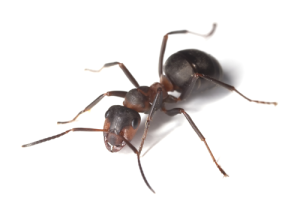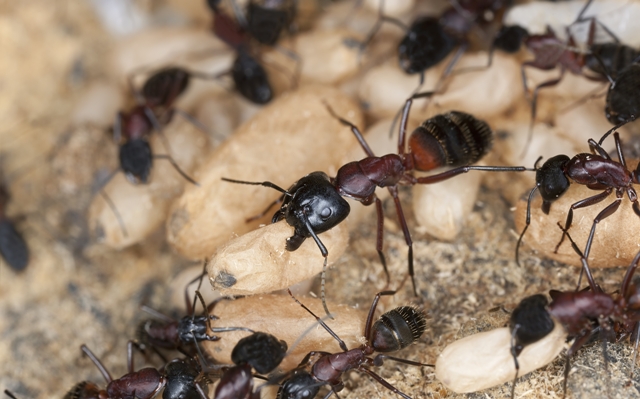 Ants can become a serious pest problem if not controlled and managed properly. Canada has over 100 species of ants, of which only about 20 species infest structures. They can be challenging to get rid of them once they establish a colony in or around your home. Most do-it-yourself treatments at home remedies kill only the ants you see, while a truly effective treatment should penetrate and destroy the colony to prevent them from returning. In addition, home remedies do not take into account the fact that different kinds of ant infestations require different treatment methods.
Ants can become a serious pest problem if not controlled and managed properly. Canada has over 100 species of ants, of which only about 20 species infest structures. They can be challenging to get rid of them once they establish a colony in or around your home. Most do-it-yourself treatments at home remedies kill only the ants you see, while a truly effective treatment should penetrate and destroy the colony to prevent them from returning. In addition, home remedies do not take into account the fact that different kinds of ant infestations require different treatment methods.
Common Ants Pest Species in Canada
Pharaoh Ant
Latin Name: Monomorium pharaonis
Appearance: Very small – about 1/16-inch long. Light yellow to red with black markings on the abdomen.
Habit: Relies on artificial heating in buildings to survive. Infestations commonly occur in food service areas. Will nest in any well-protected and hidden areas throughout a structure. Can also nest outdoors in lawns or gardens.
Diet: Food of all types, but especially sweets. Will also eat other insects.
Reproduction: Grows from egg to adult in about 45 days. Females live as long as 39 weeks and can lay about 400 eggs. Workers only live up to 10 weeks.
Carpenter Ant
Latin Name: Camponotus spp
Appearance: Colouration and size varies depending on species They are among the largest ants, from 1/4- to 5/8-inch long. There are about 50 species in Canada and USA of which about 23 species are known to invade and infest structures. The most common species, i.e. the black carpenter is black, but some species have reddish or yellowish colouration.
Habit: Can occur both outdoors and indoors in moist, decaying or hollow woods. They cut “galleries” into the wood grain to provide passageways for movement from section to section of the nest. Carpenter ants can leave “sawdust” behind that provides clues to nesting location.
Diet: Does not eat wood, but will feed on nearly anything people eat – particularly sweets and meats. They will also feed on other insects.
Reproduction: Queen lays 15 to 20 eggs the first year and up to 30 eggs the second year. Eggs complete their life cycle in about 60 days. Worker ants can live up to seven years, while a queen may live up to 25 years.
Fire Ant
Latin Name: Solenopsis
Appearance: Reddish, about 1/4-inch long.
Habit: Nest in mounds of 1 to 2 feet in diameter and about 1/2-foot high. Large colonies can have up to 250,000 workers. Very active and aggressive, they will sting any intruding animal repeatedly.
Diet: Omnivorous. Known to eat meats, greasy and sweet materials.
Reproduction: Total time from egg to adult averages 30 days; workers live up to 180 days; queens live two to six years.
Odorous Ant
Latin Name: Tapinoma sessile
Appearance: Dark reddish-brown to black and 1/10-inch long. Antennae have 12 segments.
Habit: Nests found in a great variety of situations. Inside buildings, they are often found nesting in the walls or beneath the floor. They are most likely to invade buildings during rainy weather. They travel in trails, foraging day and night.
Diet: Honeydew melons in the wild. Inside buildings, they prefer sweet items.
Reproduction: Each female in the nest lays one egg a day; young reach adulthood in an average of 24 days; workers and females live for several years.
Pavement Ant
Latin Name: Tetramorium caespitum
Appearance: Light brown to black with appendages lighter than rest of the body. About 1/10th of an inch long. Parallel lines on head and thorax with 12-segment antennae.
Habit: Invades buildings while foraging for food throughout the year. Nests are outdoors under stones, along curbs or in cracks of pavement. They can nest indoors in walls and under floors.
Diet: Omnivorous. Will eat many things, but prefers greasy and sweet foods.
Reproduction: Queen produces five to 20 eggs per day; brood develops in about 40 days; young go through three larval stages.
Thief Ant
Latin Name: Solenopsis molesta
Appearance: One of the smallest ants, about 1/32- to 1/16-inch long. Antennae have 10 segments. They range in color from yellowish to brown.
Habit: Nests occur in a great variety of locations outside, especially under rocks. May nest indoors in cracks and cupboards.
Diet: Feeds on immature forms of other ants and insects. Also attracted to greasy or high-protein foods, such as cheese and animal matter.
Reproduction: Queens lay an average of 105 eggs, which incubate for 16 to 28 days. Larval stage may last 21 days in summer, but can last throughout the winter.
Prevention tips
- Maintain your kitchen clean as ants are attracted by food.
- Sweep the floor regularly after meals, even little messes can easily attract ants.
- Never leave dishes unwashed in the sink.
- Keep trash cans and bins far from your house.
- Take the trash out regularly.
- Don’t allow moisture on counters and other surfaces, as ants keep searching for water sources and stay nearby.
- Clear any old vegetation from backyard and outdoor areas immediately.

